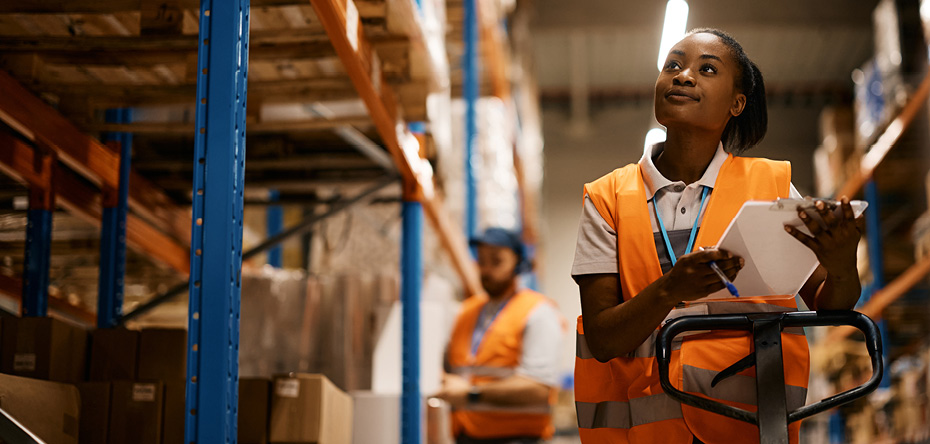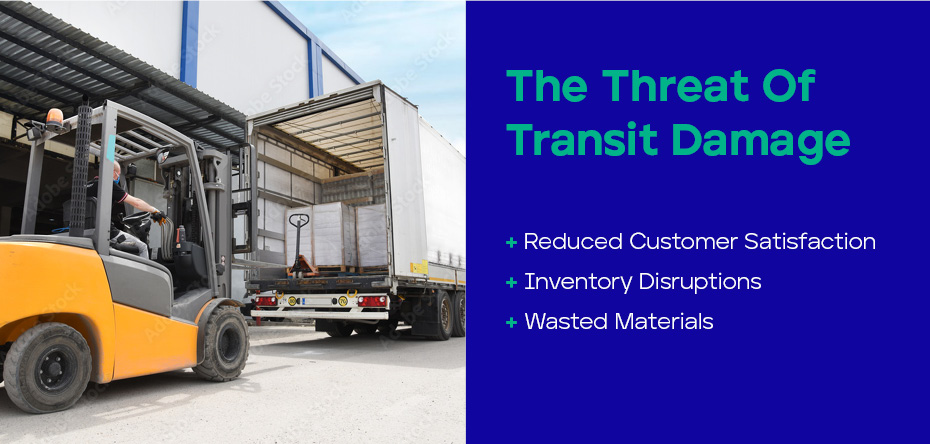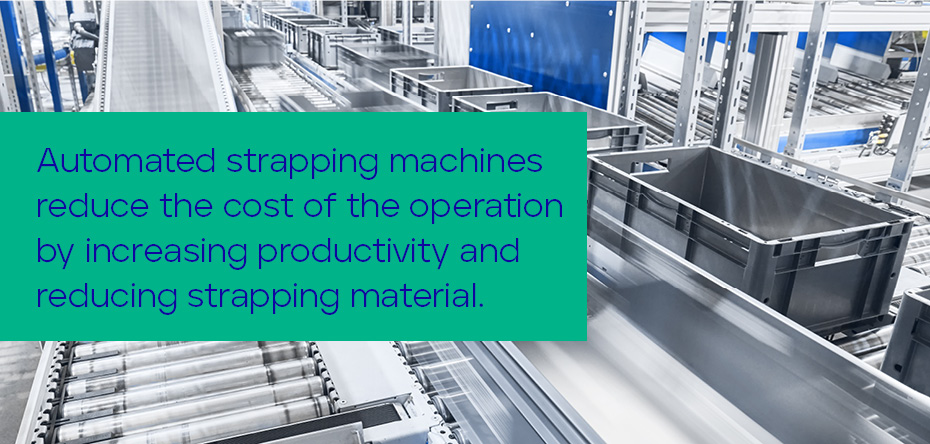Package Protection for Efficiency and Cost Savings
Protecting goods with effective packaging material is essential to avoiding damage, but that protection comes at a high cost. Achieving a balance between cost-effective packaging solutions and product protection is possible. Finding that balance will save money over time and help prevent package damage during transit.
The Cost of Packing and Shipping
Packing and shipping costs contribute to a significant percentage of company spending each year — and with ecommerce sales estimated to account for nearly 22% of all retail sales in the U.S. by 2025, many businesses’ packing and shipping costs will continue rising.
Much of that cost comes from packing issues, like over or underfilling boxes. Partially filled shipments leave more room for cardboard to become crushed and make it easier for the items inside to move around during transit. For extra protection during shipment, packing materials must fill any empty space inside the container to cushion the products inside and reduce movement inside the box. Cushioning materials contribute to the total companies spend on packing products for safe shipment.
Overpacked boxes are too heavy for efficient load and transport, and they can create unbalanced shipment weights. Packing a container beyond its limits also leads to damaged products, wasted shipping materials, and trucks ultimately transporting smaller loads than necessary.
Another cost of packing and shipping comes from the strapping system and materials used to seal containers. Strapping systems include manual and table-top varieties for low-volume packaging needs. Operator-assisted and fully automatic strapping machines reduce the time required for creating strong seals on packages. The investment into these machines and the strapping materials used, either polypropylene (PP) or polyester (PET) straps, also add to the total cost of packaging goods.
Many companies can benefit from improving packing and shipping operations, especially in these areas:
- Lowering shipping costs
- Cutting waste and excessive spending on packaging materials
- Reducing damage during shipping
- Speeding workflow during packaging
- Enhancing product protection during shipping
Shipping costs include the method of shipment and the cost of lost products from damage. Products broken or containers opened during shipping can contribute to company losses and add more to the total cost of packaging and shipping goods.
The Threat of Transit Damage
A major cost factor in shipping is the threat of damage to goods. While some products are easily reshipped if damaged, other goods are irreplaceable. For these items, damage during transit is unacceptable.
Transit damage has multiple ramifications for businesses, all of which can impact the bottom line:
- Reduced customer satisfaction: Damaged goods reduce customer satisfaction and delay the time for customers to get their products. In cases of paid returns, businesses incur the cost of shipping the damaged items back to them and sending out new goods.
- Inventory disruptions: When sending goods to retailers, damaged products reduce the number of items on the shelf. Without as many products to sell, the retailer cannot produce the expected sales of the company’s goods.
- Wasted materials: Damaged products directly cut into profits by costing the company the production, packaging, and shipping costs without a return on investment from sales. Even small percentages of product loss from damages can significantly reduce a company’s profit margin.
With the threat of damage during shipping a constant, companies need to consider their packaging methods to best prevent it. Everything from the container type, strapping material and method, and filler materials contribute to reducing the chances of product damage. Investments in these end-of-line goods and processes produce returns in preventing product damage.
How Are Packages Damaged in Transit?
Package damage comes from several sources. The most common causes of damage include vibrations, abrasion, and crushing from load instability.
- Vibrations: Damage caused by vibrations can occur suddenly from impacts or slowly from too much handling during shipping. Sudden impacts may happen when packages drop to the ground. Transportation fatigue occurs from vibrations caused by transportation trucks or plane engines vibrating contents inside the container. Storage fatigue may happen when crews handle or move a package too often, resulting in container or product damage. Vibrations can ultimately weaken the packaging or product, while sudden impacts can break improperly packed fragile goods.
- Abrasion: Abrasion damage is more subtle than other types of harm that happen during transit. Containers or products may have printing or painting rubbed off as the products move around inside the container and brush repeatedly against other products, the packaging, or the filler material. For products with delicate coatings, this type of damage can easily occur.
- Load instability: Load instability is the type of damage most difficult to prevent because the carrier and not the type of packaging is at fault. It can severely damage entire pallets of products. Incorrect pallet stacking in storage facilities or transportation vehicles often causes this damage. Pallets stacked too high have a greater risk of toppling, causing potential injuries to bystanders while ruining the products on the pallet. Cornering in a vehicle with incorrectly stacked loads can also cause products to fall. Damage caused by load instability typically is crushing or breaking damage to both the products and their containers.
Knowing the types of package damage that occur during transit will make prevention easier by choosing containers and packing methods that combat product destruction during shipping.
Preventing Transit Damage With Proper Strapping
Strapping can prevent packages from opening during transit. Some types of machines will even emboss the strapping to provide a tamper-evident seal. The right strapping machinery and materials can save money on packaging and prevent transit damage.
Automated strapping machines reduce the cost of operation by increasing productivity and reducing strapping material. Some types of SoniXs system machines can band up to 50 products a minute, much faster than individuals can do alone. These machines also measure and use strapping material more precisely than people can. Manual hand strappers often overestimate the amount of material to use. Some companies have switched to a SoniXs strapping machine and saved 100 feet of strapping per coil. By operating faster and using less material, fully automated strapping machines save time and money on this portion of the packaging process.
Secure strapping at the correct tension level prevents damage. Some goods packed too tightly, such as softer bundles, may sustain damage from strapping that is too tight. Other materials, such as heavy containers or pallets require tighter strapping to prevent movement during shipping. Strapping machines that provide a range of tension options can readily meet the variety of needs for multiple packages or pallets.
Machinery used to seal strapping, such as the SoniXs machines, create a tamper-evident seal that verifies the product arrived unopened. The SoniXs machinery also ensures the best tension and amount of strap to use for a package for the most secure closure and greatest material saving.
Properly strapping shipping packages reduces damage caused by containers that open during transit from thieves or accidents. The materials and machinery used for strapping packages are only one small part of the process. Other ways to save money on packing and shipping exist, and can optimize spending when using multiple measures and quality strapping systems.
Other Ways to Reduce Packaging Material Costs
The most cost-effective packaging material will provide adequate protection at an affordable price. Including protection levels and savings from avoiding transit damage into the price of packaging products will provide a more realistic cost. The following are other options to cut total packaging and shipping costs:
1. Improve Packing Efficiency
Look for more efficient packing methods. Organization of the packing area is key to cutting time and providing workers with the products they need for efficiently and securely packing goods.
Layout the variety of boxes and filler materials in clearly labeled and organized locations. Storing packing materials near the packing and shipping area of a business reduces time wasted finding containers or filler. Place the most frequently used packing materials closest to the packing area and the least often used in a more remote storage place.
Create a single packing spot for all products to filter into for packing and shipping to keep materials and workers close while minimizing the space required for this part of the process.
In-house container production is another option to improve packing efficiency in larger facilities if you have the means to invest in it. The box-making machines could reduce extra costs incurred by purchasing and storing extra containers for packing. Place the box maker and materials it uses near the packing area to optimize the efficiency and productivity of those in the area.
Another time-saving feature to include in the packing area includes the strapping equipment. Machines for this purpose include manual, operator-assisted, or fully automatic, to meet any business’s budget and productivity needs.
2. Employ Automated Solutions
Automating portions of the packing process can cut time and save money. Packaging line setup with automated equipment from cardboard carton assembly to filling to strapping can happen faster and more accurately with machinery’s assistance.
Adding machinery could require additional maintenance, but some options have low-maintenance needs while increasing output. SonixS strapping machines do not have high maintenance requirements because they do not create sticky substances during strapping like other types of heat sealing machinery does. With no fumes or smells, these machines also make the environment for nearby workers safer and more comfortable.
3. Try Different Materials
The materials used for packing may not be the most cost-efficient. Corrugated cardboard comes in a variety of types based on the material used, thickness, and type of construction. Choosing more secure, durable cardboard for boxes could reduce the need for extra strapping or packing to keep containers intact and products protected.
Choices for void fill could raise or lower the total price of packing. For example, switching to a more economically priced alternative could cut overall packing costs. Options using more air as a cushion reduce both costs and waste. Some facilities use waste regeneration or recycling to create eco-friendly filler that also helps minimize costs.
The best option is to minimize the use of filler materials by choosing container sizes that closely match the products.
4. Use Smaller Boxes
Smaller boxes reduce the need for additional filler material. Less space around the products means cutting down filler used to cushion the goods inside. Using less void fill reduces overall waste produced and minimizes the cost of filler.
Smaller, more precise shipping container sizes free more space for box storage in storage rooms and on pallets. More products can ship at once, increasing potential profits while reducing costs. Experienced workers may be able to choose the correct box sizes for packing products. This method works well for consistent product dimensions.
Automated packing machines that select the correct size box reduce time and costs, and many programs or facilities can help you create custom-sized packaging and boxes to fit your products’ specific dimensions and shipping considerations.
You could also work with a packaging expert or product engineer to implement creative multi-use packaging and boxes to increase the materials’ value.
5. Vary Costs Based on Durability of Goods
Create a scale of shipping charges based on the products’ durability and packing requirements. Compensation for packing more closely matches the amount spent on materials and handling. Workers can then use the most secure methods to reduce damage in transit for fragile items while using more economical packaging options for durable goods.
The categories of goods used for this type of cost variation may include the following:
- Fragile products at a higher percentage of the product cost for packing fees
- Durable goods have lower packing fees than fragile or standard items
- Complex materials have the highest percentage of their price for shipping due to custom-made shipping containers or specialty packaging methods or materials
Basing the shipping costs on a percentage of the product’s price and its packaging requirements ensures that income more closely matches the amount of time and materials needed for packing. This method gives customers and companies the best balance of product protection and cost.
Improve Your Packing and Shipping Costs With EAM-Mosca Corporation
For packaging cost optimization, reconsider the type of strapping materials used and the machinery used to place it. With the SoniXs sealing system from EAM-Mosca Corporation, packages have a reliable, tamper-evident seal. The sealing machines that use this technology operate more efficiently than heat seal alternatives and don’t require warmup or produce smoke or fumes. They also require minimal maintenance. For versatility, SoniXs sealing machines can use either PP or recyclable PET straps using a range of tensions.
Find out more about the SoniXs solution for packaging and how it could reduce packing costs by contacting EAM-Mosca Corporation.




